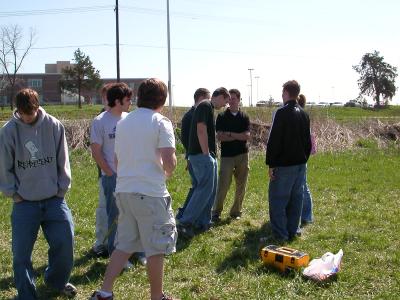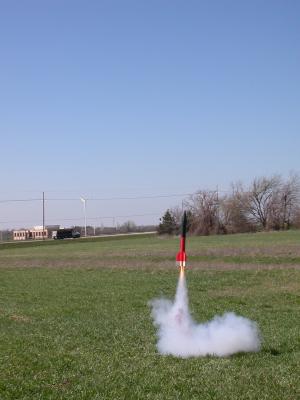Launch date and time: April 1, 2004 at 9:30AM
Launch location: Olathe, KS
Launch wind and weather: Cool and Calm winds
 |
| Teams on the field |
Mr Keiter (rhymes with lighter) first contacted me in late September 2003 via e-mail to ask some specific questions about the Team America Rocketry Challenge. Mainly he wanted to know where to get parts for rockets and what help I could offer. He also told me that he had three teams and was building an entire curriculum around the Challenge! We communicated via e-mail on and off for a couple of months; my amazement slowly growing until the end of March when Mr. K. was looking for a minimum of eight packs of D12-0’s and hoping for 20 packs. It would seem that someone (another TARC Team, no doubt) latched on to the ones he had ordered through a local shop.
So the big day finally arrived: qualification day, April Fools Day, no less!
I arrived at the school at about 9:15, and checked in at the office as requested. What a nice school with a large field on one side. I found the classroom with no problem — it turned out to be a well equipped laboratory, full of kids and rockets. We talked for a few minutes, then the teams brought their rockets up to the front and we weighed them. It was at this point that I realized that I neglected to bring my notebook. I improvised by writing notes on the back of the pages of my copy of the rule book.
The rockets looked like they had a lot of effort put into them, and that they had undergone some flight testing and modification. I asked the teams as they weighed in what stage of design they were in (i.e., original rocket, redesigned, same one but modified, etc.). All three teams are still using the same basic design with a bit of modification to the original rocket. None of the rockets were too heavy and all weigh between 700 and 900-grams. They were all uniform BT-80 airframes. I asked the obvious but important question; “Have these rockets been flown before?” And received the resounding answer: “Yes!”
The teams did have the airframes marked with CP and CG data. All three rockets had margins that appeared to be very close to 1 caliber (eyeball measurement). The teams understand about the center of pressure and gravity relationship, but paradoxically didn't seem to understand the question: “What’s your margin of stability?” So I warned them that they need to find out what the margin means, and find the value for their rocket because they were sure to be asked for it at the National Event, should they be so lucky as to be invited. We discussed what the standard rule-of-thumb values are, and how weight and balance would affect it, and what the exceptions and trade-offs would be. We also discussed why it’s import to know and understand the stability margins.

The Team 2 rocket leaves the rod for a successful flight |
While Team 2 was out retrieving, Team 3 set up. This team’s rocket is the longest of the three teams, I didn’t measure it, but it appears to be just shy of three feet long. It tipped the scale at about 900 grams and is therefore the heaviest of the three teams. It uses four D12-0’s in the booster, and a single E9-6 in the sustainer. It has four fins per stage and has an Orange and Blue color scheme. The recovery system is a singe X-form ’chute. The sky was checked again for aircraft and Mr. K. counted down and it left the pad in a rush with all four jets clearly visible. It staged well with a little bit of wobble. The sustainer carried on in the same direction despite the wobble and ejected with nose level. Unfortunately it managed to find some concrete to land on which shook loose the altimeter battery. Nuts! Scratch one attempt!
Team 1 was up next. Their rocket sports a Silver and Black scheme and uses four D12-0 booster motors staging to a single E9-6 for the sustainer. It has three fins per stage. The sky was checked again, and count down commenced. It left the pad with a “Whoosh!” and staged. The sustainer continued without changing course despite a brief wobble when the booster motors sputtered as they ignited the sustainer motor. The ejection happened just past apogee, and twin X-form ’chutes carried it across the road. The altimeter was beeping out 1193 — that’s a score of 57!
Team 2 glued a fin back on, and (after some coaching) wired the battery into the holder on the altimeter. They mooched four D12-0’s from me and made another attempt. This time the rocket flew in a long arc, staged well, and ejected with the nose cone level. It was still traveling pretty fast, but the recovery system held and it wound up landing on the track (which is in the opposite direction of the road.) This time the altimeter was beeping out 1070 and the eggs are OK! Score of 180.
The boosters of all three rockets either tumbled, or twirled around the long axis rapidly, or seemed to flutter. In any case, they all recovered safely despite being pretty heavy and without benefit of a streamer or ’chute.
Some additional comments:
I noticed that all three teams were using Nomex® ’chute protectors. I also noticed the very thin fins on Team 1’s bird and discussed this with one of the team members; they are using 1/32-inch G10. I noticed that Team 2 & Team 3 appear to be using good old fashioned balsa, however. Some good technology is being used here.
We went back up to the lab where I finished filling out the paper work. I asked the kids some questions, and offered to answer any questions that I could. They thanked me for helping when we were through talking. The kids seem very comfortable with their instructor; but rallied when called and did as instructed. I remember having teachers like that: leaders — The best sort.
The three teams’ rocket designs are suspiciously similar though clearly different and obviously the product of three different design teams. I asked Mr. Keiter about this, and his observation was that one team found something that seemed to work and the other two hopped on that idea. He was thinking about how he could encourage more unique designs next year. Maybe extra points for the sexiest airframe, Mr. K? I had brought along my answer to the challenge for comparison (I figure if I’m going to be mentor and serve as observer it would be good if I had done it once myself). The idea of transitioning to a smaller diameter had all of the teams and Mr. K. intrigued. I was specifically asked how I fashioned the transition on the booster. Wheels are turning!
Mr. K. indicated how supportive the school’s principle was with the effort; it was pretty expensive to register three teams with TARC, and he had to purchase tools, and ground support equipment, etc. to make it happen. Naturally, this equipment can all be used again next year so it’s an investment. The students are obviously learning a great deal of things from the experience; good aerospace design, and applied science — going from an idea to paper (or computer model) to tangible models, troubleshooting, trial & error development (er . . make that “incremental engineering”) . . . you get the idea, I think. They’ve also had some real-world experiences that occur such as procurement problems. They are also learning good team-working skills that will pay dividends later. I happened to meet the principle on the way out of the building (she saw me on my way back to the office to check out with a rocket in my hand and wanted to meet me). She seemed truly interested in how the teams were doing. She also thanked me for coming by (as though I would miss it!)
So, April Fools Day or not, three teams qualified; two with good scores and one with a very good score! Cool!
| Flight # |
Flier | Rocket | Motor(s) | Comments |
|---|---|---|---|---|
| 1 | Team 2 | Black & Red | 3XD12-0 to 2XD12-7, C6-7 | Nice flight; staged well (with a bit of wobble). ’Chute opened just past apogee. Eggs good! Beeping 1355 feet. |
| 2 | Team 3 | Blue & Orange | 4XD12-0 to E9-6 | Very nice! Spun in flight, staged well. Ejected with nose level. Alas, landed hard on a hard surface and knocked the battery out of the altimeter. |
| 3 | Team 1 | Silver & Black | 4XD12-0 to E9-6 | Good flight! Boost was nice and straight, and staged well even though it sputtered a bit and wobbled some. Ejected just past apogee; beeping out 1193-feet. |
| 4 | Team 3 | Blue & Orange | 4XD12-0 to E9-6 | This flight was a bit better than the first; no roll this time but an arcing flight profile cost it some altitude. Beeping out 1070-feet. |
All four flights were staged and clustered flights.

Team 1 loads their rocket on the rod |
| ||||||||||||||||||||||||

Team 3 gets ready for the second attempt |
|
Some “out-loud” ideas for possible improvement. Team 1 is closest to the goal, though not the lightest rocket. It already has thin fins, and is pretty well maxed-out on motors; so how do they squeeze out another 50+ feet? They might consider switching out two D12’s for two D11-Ps which have a slightly higher total impulse. An E9 is the biggest they can use in the sustainer because of the ban on AP propellant in upper stages so they can’t juice up the sustainer any. It might be a good idea to look into switching to E9-P motors for two of the booster motors, but they should consider burn times very carefully before pursuing something like that. I would try sanding the fillets until smooth, and maybe re-do them with epoxy to get some really good round ones. Then work on the overall finish until it too is glass smooth. Lot’s of elbow grease with 600 grit and finer sandpaper, and then a coat of wax, polished.
Team 2’s effort would certainly be improved with airfoiled fins, and a good shiny finish on the entire rocket. However, since they are over-shooting rather than falling short, they might simply consider using three C11-5 motors in the sustainer rather than two D12’s and a single C6 and not worry about improving performance at all. Since they are over, they might just add some ballast. Some experimentation is in order here.
And finally, Team 3 has the same problems with being maxed out on motors as Team 1 and might consider switching to two E9-P or D11-P motors as discussed above. Also as mentioned above, some careful consideration should be done regarding burn lengths first! They might also consider a cleaner airframe — see above regarding smooth fillets, finishes, and airfoiled fins. Another possible solution would be to look for ways to decrease the surface area (thereby decreasing static drag) such as shortening the rocket, if possible, or going with thinner fins.
In any event, all three teams have my congratulations and sincere admiration for going from a “zero return rate” when first starting out with simple kits to being able to design and successfully build and fly relatively complex rockets that change configurations in flight. And if that isn’t enough, all three teams managed to get decent scores in qualifying, too!
Submitted by Tim Burger NAR 78486 L1
Return to reports index.
Return to home page.
Page created on April 1, 2004.
Last updated on May 3, 2004.